Analysis of Health Care Information Technology Environment and Systems
VerifiedAdded on 2022/11/22
|7
|1683
|499
Report
AI Summary
This report provides a comprehensive analysis of the current health care information technology environment, focusing on the integration of health information systems within Vila Health hospitals. It examines industry trends, challenges, and incentive programs like MIPS, while also differentiating the specific data gathering needs of each hospital. The report evaluates the existing EHR systems and their ability to facilitate interoperability and data exchange, offering recommendations for system improvements and compliance. It also delves into the complexities of data security, regulatory compliance, and the integration of virtualized IT infrastructure. The analysis includes recommendations for enhancing IT penetration, integrating various healthcare participants, and improving patient access to medical data, with an emphasis on leveraging electronic medical history data. The report's findings are supported by a content analysis of scientific papers and an assessment of the existing medical information technology infrastructure.
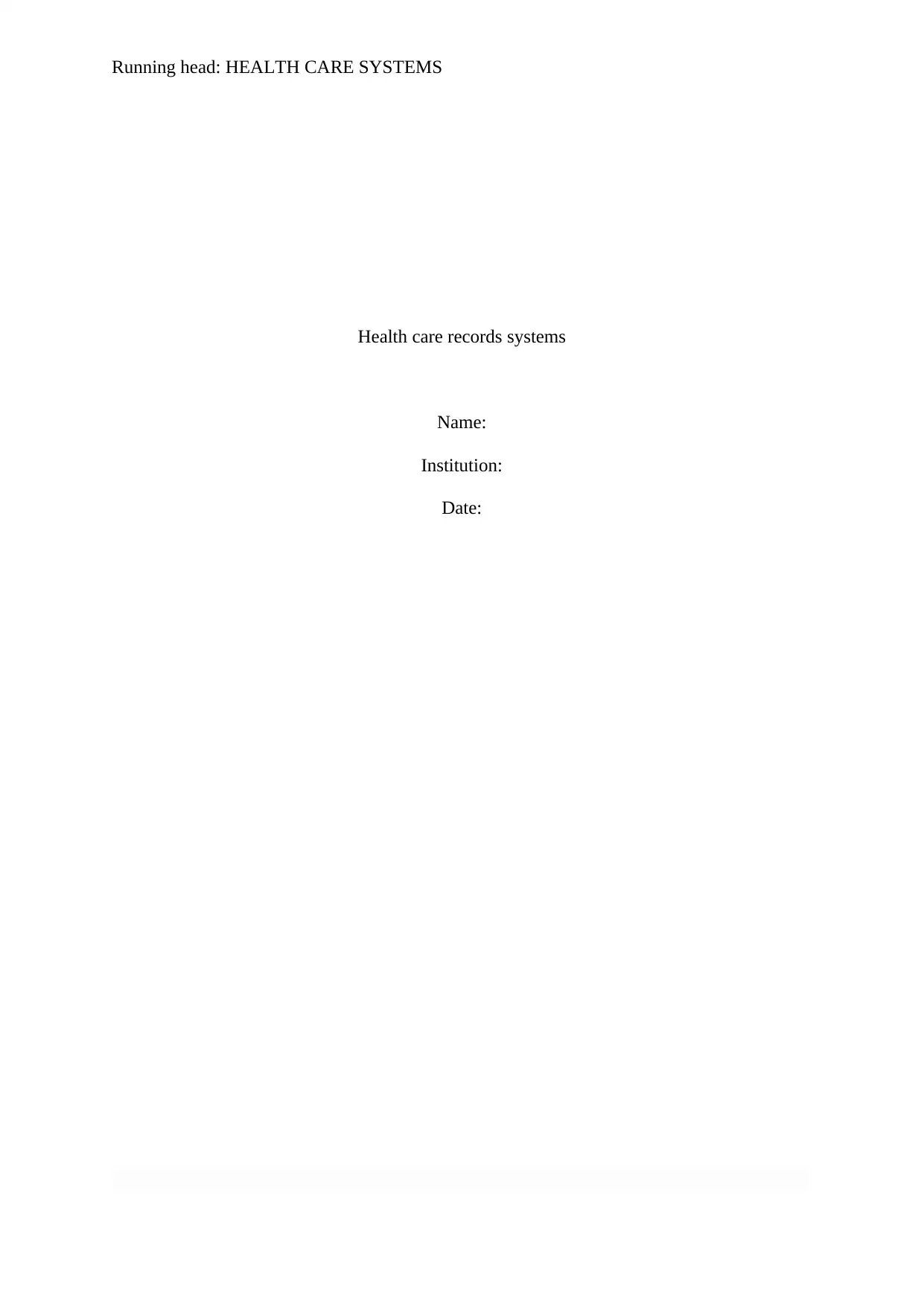
Running head: HEALTH CARE SYSTEMS
Health care records systems
Name:
Institution:
Date:
Health care records systems
Name:
Institution:
Date:
Paraphrase This Document
Need a fresh take? Get an instant paraphrase of this document with our AI Paraphraser
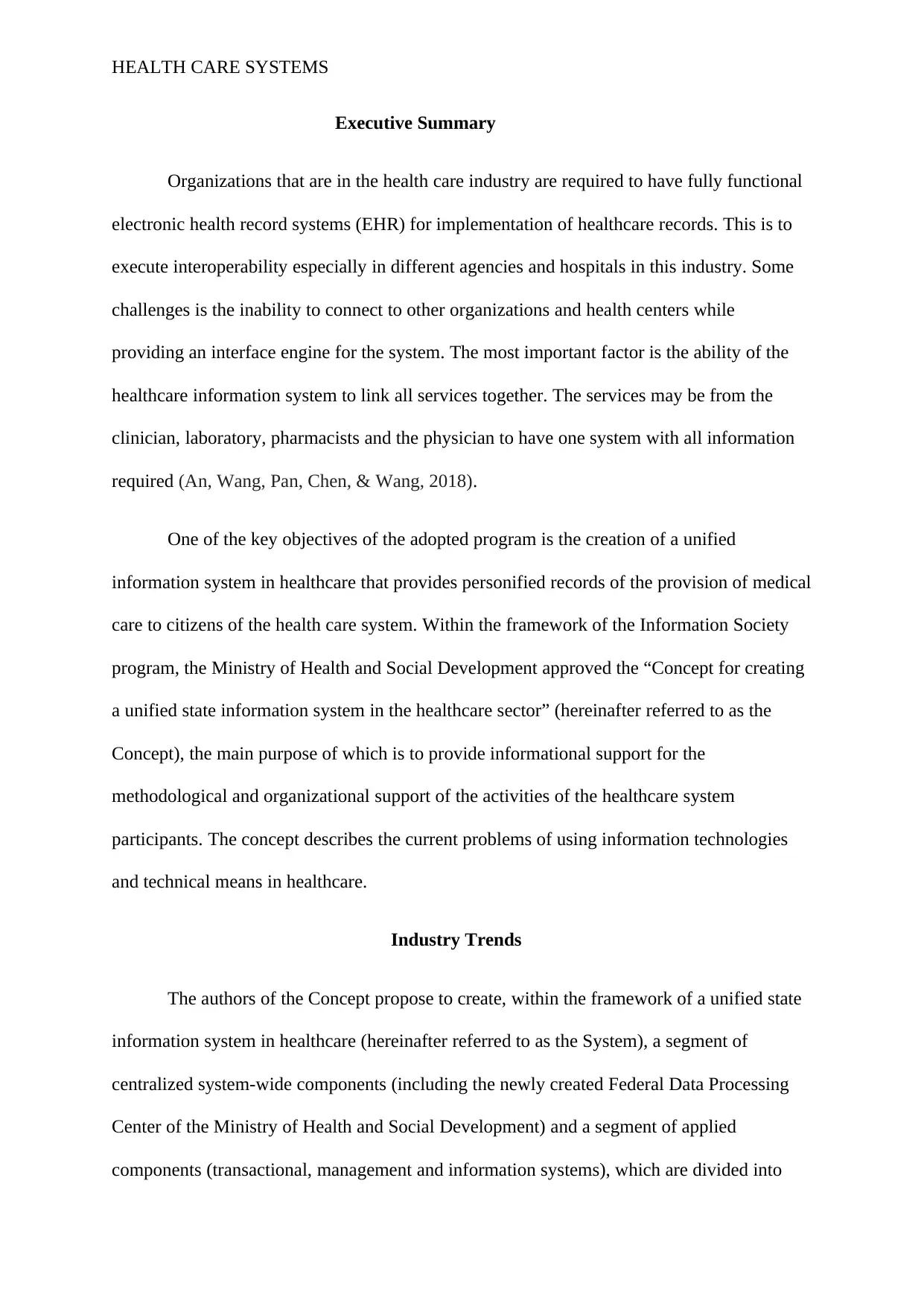
HEALTH CARE SYSTEMS
Executive Summary
Organizations that are in the health care industry are required to have fully functional
electronic health record systems (EHR) for implementation of healthcare records. This is to
execute interoperability especially in different agencies and hospitals in this industry. Some
challenges is the inability to connect to other organizations and health centers while
providing an interface engine for the system. The most important factor is the ability of the
healthcare information system to link all services together. The services may be from the
clinician, laboratory, pharmacists and the physician to have one system with all information
required (An, Wang, Pan, Chen, & Wang, 2018).
One of the key objectives of the adopted program is the creation of a unified
information system in healthcare that provides personified records of the provision of medical
care to citizens of the health care system. Within the framework of the Information Society
program, the Ministry of Health and Social Development approved the “Concept for creating
a unified state information system in the healthcare sector” (hereinafter referred to as the
Concept), the main purpose of which is to provide informational support for the
methodological and organizational support of the activities of the healthcare system
participants. The concept describes the current problems of using information technologies
and technical means in healthcare.
Industry Trends
The authors of the Concept propose to create, within the framework of a unified state
information system in healthcare (hereinafter referred to as the System), a segment of
centralized system-wide components (including the newly created Federal Data Processing
Center of the Ministry of Health and Social Development) and a segment of applied
components (transactional, management and information systems), which are divided into
Executive Summary
Organizations that are in the health care industry are required to have fully functional
electronic health record systems (EHR) for implementation of healthcare records. This is to
execute interoperability especially in different agencies and hospitals in this industry. Some
challenges is the inability to connect to other organizations and health centers while
providing an interface engine for the system. The most important factor is the ability of the
healthcare information system to link all services together. The services may be from the
clinician, laboratory, pharmacists and the physician to have one system with all information
required (An, Wang, Pan, Chen, & Wang, 2018).
One of the key objectives of the adopted program is the creation of a unified
information system in healthcare that provides personified records of the provision of medical
care to citizens of the health care system. Within the framework of the Information Society
program, the Ministry of Health and Social Development approved the “Concept for creating
a unified state information system in the healthcare sector” (hereinafter referred to as the
Concept), the main purpose of which is to provide informational support for the
methodological and organizational support of the activities of the healthcare system
participants. The concept describes the current problems of using information technologies
and technical means in healthcare.
Industry Trends
The authors of the Concept propose to create, within the framework of a unified state
information system in healthcare (hereinafter referred to as the System), a segment of
centralized system-wide components (including the newly created Federal Data Processing
Center of the Ministry of Health and Social Development) and a segment of applied
components (transactional, management and information systems), which are divided into
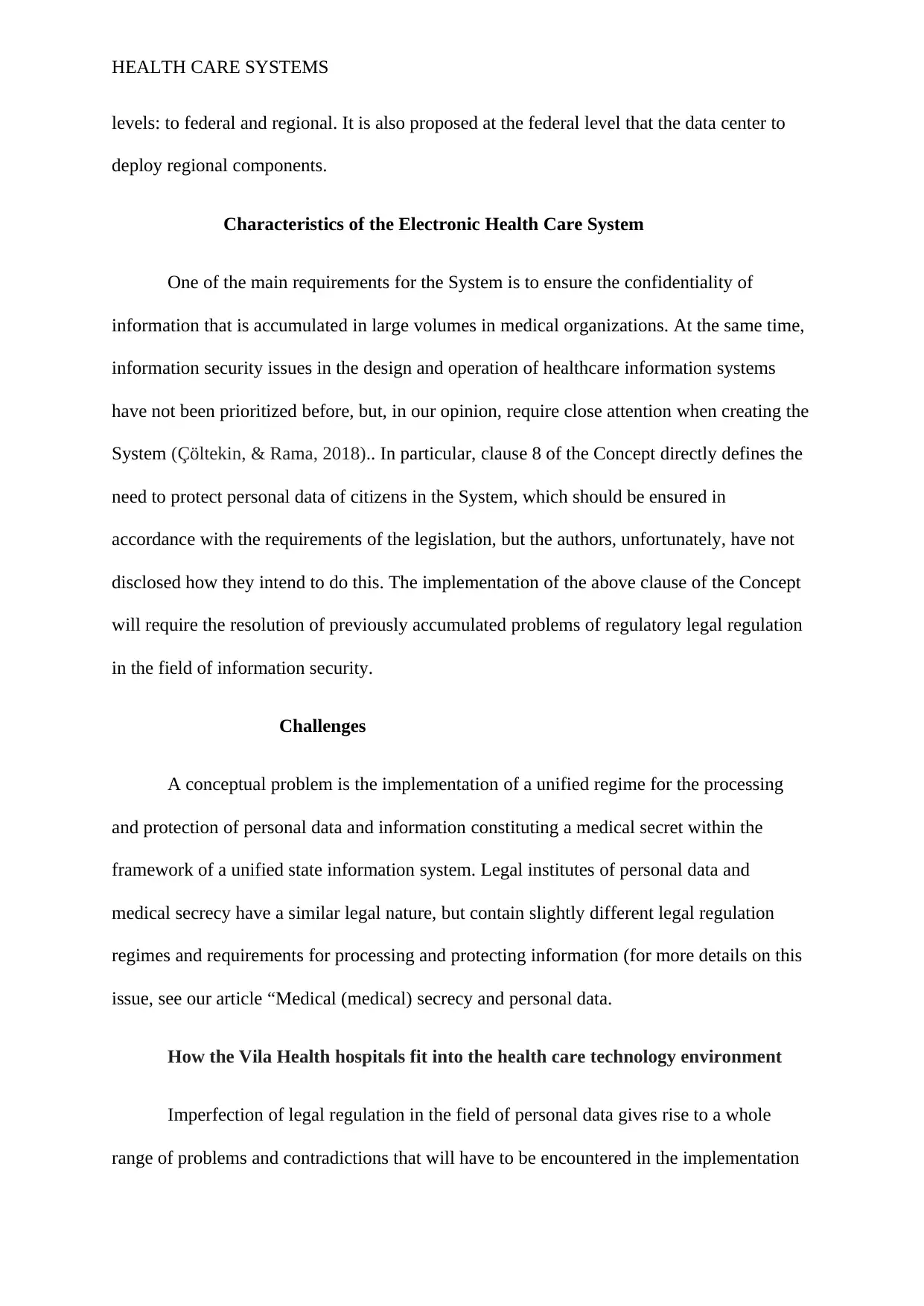
HEALTH CARE SYSTEMS
levels: to federal and regional. It is also proposed at the federal level that the data center to
deploy regional components.
Characteristics of the Electronic Health Care System
One of the main requirements for the System is to ensure the confidentiality of
information that is accumulated in large volumes in medical organizations. At the same time,
information security issues in the design and operation of healthcare information systems
have not been prioritized before, but, in our opinion, require close attention when creating the
System (Çöltekin, & Rama, 2018).. In particular, clause 8 of the Concept directly defines the
need to protect personal data of citizens in the System, which should be ensured in
accordance with the requirements of the legislation, but the authors, unfortunately, have not
disclosed how they intend to do this. The implementation of the above clause of the Concept
will require the resolution of previously accumulated problems of regulatory legal regulation
in the field of information security.
Challenges
A conceptual problem is the implementation of a unified regime for the processing
and protection of personal data and information constituting a medical secret within the
framework of a unified state information system. Legal institutes of personal data and
medical secrecy have a similar legal nature, but contain slightly different legal regulation
regimes and requirements for processing and protecting information (for more details on this
issue, see our article “Medical (medical) secrecy and personal data.
How the Vila Health hospitals fit into the health care technology environment
Imperfection of legal regulation in the field of personal data gives rise to a whole
range of problems and contradictions that will have to be encountered in the implementation
levels: to federal and regional. It is also proposed at the federal level that the data center to
deploy regional components.
Characteristics of the Electronic Health Care System
One of the main requirements for the System is to ensure the confidentiality of
information that is accumulated in large volumes in medical organizations. At the same time,
information security issues in the design and operation of healthcare information systems
have not been prioritized before, but, in our opinion, require close attention when creating the
System (Çöltekin, & Rama, 2018).. In particular, clause 8 of the Concept directly defines the
need to protect personal data of citizens in the System, which should be ensured in
accordance with the requirements of the legislation, but the authors, unfortunately, have not
disclosed how they intend to do this. The implementation of the above clause of the Concept
will require the resolution of previously accumulated problems of regulatory legal regulation
in the field of information security.
Challenges
A conceptual problem is the implementation of a unified regime for the processing
and protection of personal data and information constituting a medical secret within the
framework of a unified state information system. Legal institutes of personal data and
medical secrecy have a similar legal nature, but contain slightly different legal regulation
regimes and requirements for processing and protecting information (for more details on this
issue, see our article “Medical (medical) secrecy and personal data.
How the Vila Health hospitals fit into the health care technology environment
Imperfection of legal regulation in the field of personal data gives rise to a whole
range of problems and contradictions that will have to be encountered in the implementation
⊘ This is a preview!⊘
Do you want full access?
Subscribe today to unlock all pages.

Trusted by 1+ million students worldwide
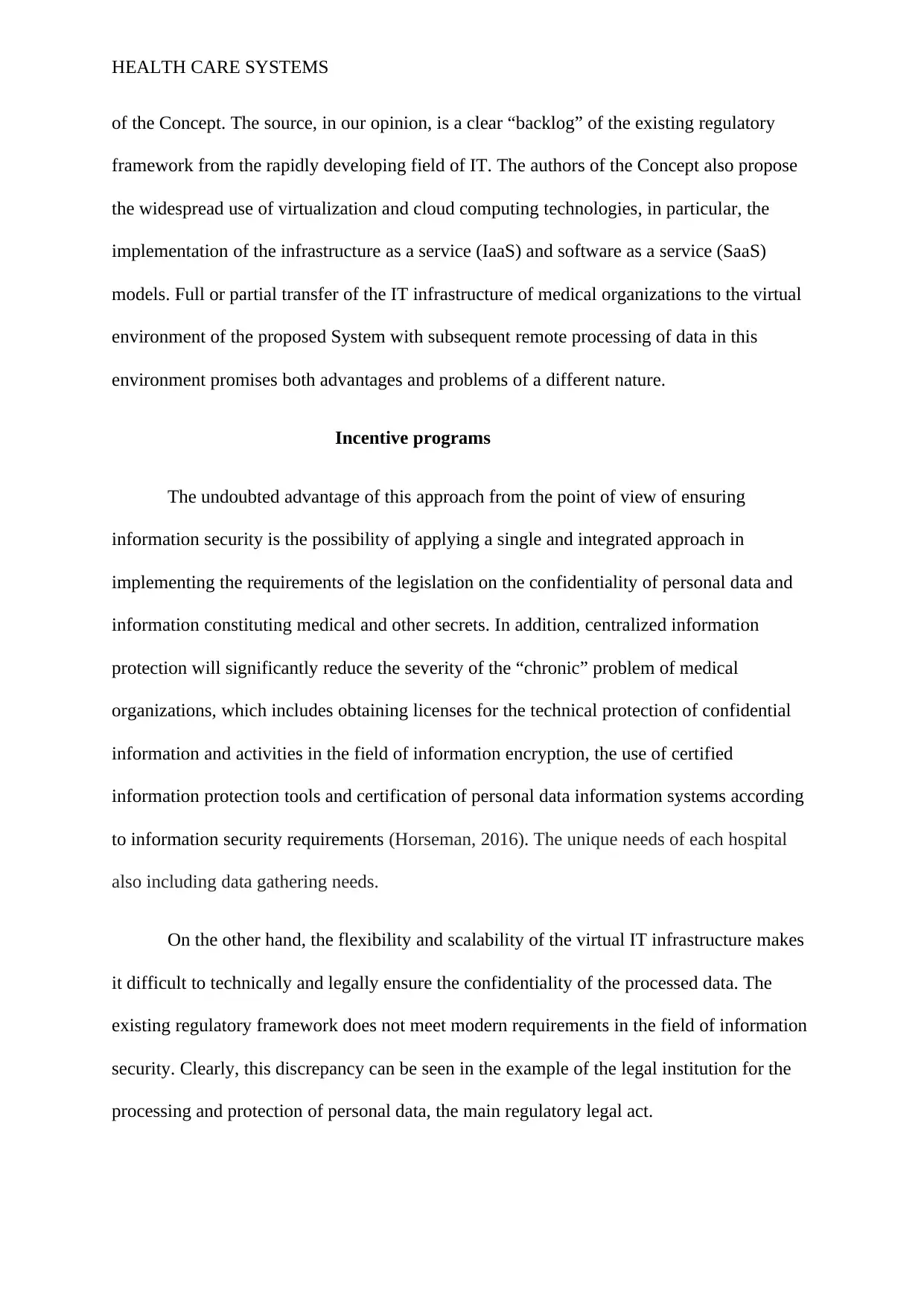
HEALTH CARE SYSTEMS
of the Concept. The source, in our opinion, is a clear “backlog” of the existing regulatory
framework from the rapidly developing field of IT. The authors of the Concept also propose
the widespread use of virtualization and cloud computing technologies, in particular, the
implementation of the infrastructure as a service (IaaS) and software as a service (SaaS)
models. Full or partial transfer of the IT infrastructure of medical organizations to the virtual
environment of the proposed System with subsequent remote processing of data in this
environment promises both advantages and problems of a different nature.
Incentive programs
The undoubted advantage of this approach from the point of view of ensuring
information security is the possibility of applying a single and integrated approach in
implementing the requirements of the legislation on the confidentiality of personal data and
information constituting medical and other secrets. In addition, centralized information
protection will significantly reduce the severity of the “chronic” problem of medical
organizations, which includes obtaining licenses for the technical protection of confidential
information and activities in the field of information encryption, the use of certified
information protection tools and certification of personal data information systems according
to information security requirements (Horseman, 2016). The unique needs of each hospital
also including data gathering needs.
On the other hand, the flexibility and scalability of the virtual IT infrastructure makes
it difficult to technically and legally ensure the confidentiality of the processed data. The
existing regulatory framework does not meet modern requirements in the field of information
security. Clearly, this discrepancy can be seen in the example of the legal institution for the
processing and protection of personal data, the main regulatory legal act.
of the Concept. The source, in our opinion, is a clear “backlog” of the existing regulatory
framework from the rapidly developing field of IT. The authors of the Concept also propose
the widespread use of virtualization and cloud computing technologies, in particular, the
implementation of the infrastructure as a service (IaaS) and software as a service (SaaS)
models. Full or partial transfer of the IT infrastructure of medical organizations to the virtual
environment of the proposed System with subsequent remote processing of data in this
environment promises both advantages and problems of a different nature.
Incentive programs
The undoubted advantage of this approach from the point of view of ensuring
information security is the possibility of applying a single and integrated approach in
implementing the requirements of the legislation on the confidentiality of personal data and
information constituting medical and other secrets. In addition, centralized information
protection will significantly reduce the severity of the “chronic” problem of medical
organizations, which includes obtaining licenses for the technical protection of confidential
information and activities in the field of information encryption, the use of certified
information protection tools and certification of personal data information systems according
to information security requirements (Horseman, 2016). The unique needs of each hospital
also including data gathering needs.
On the other hand, the flexibility and scalability of the virtual IT infrastructure makes
it difficult to technically and legally ensure the confidentiality of the processed data. The
existing regulatory framework does not meet modern requirements in the field of information
security. Clearly, this discrepancy can be seen in the example of the legal institution for the
processing and protection of personal data, the main regulatory legal act.
Paraphrase This Document
Need a fresh take? Get an instant paraphrase of this document with our AI Paraphraser
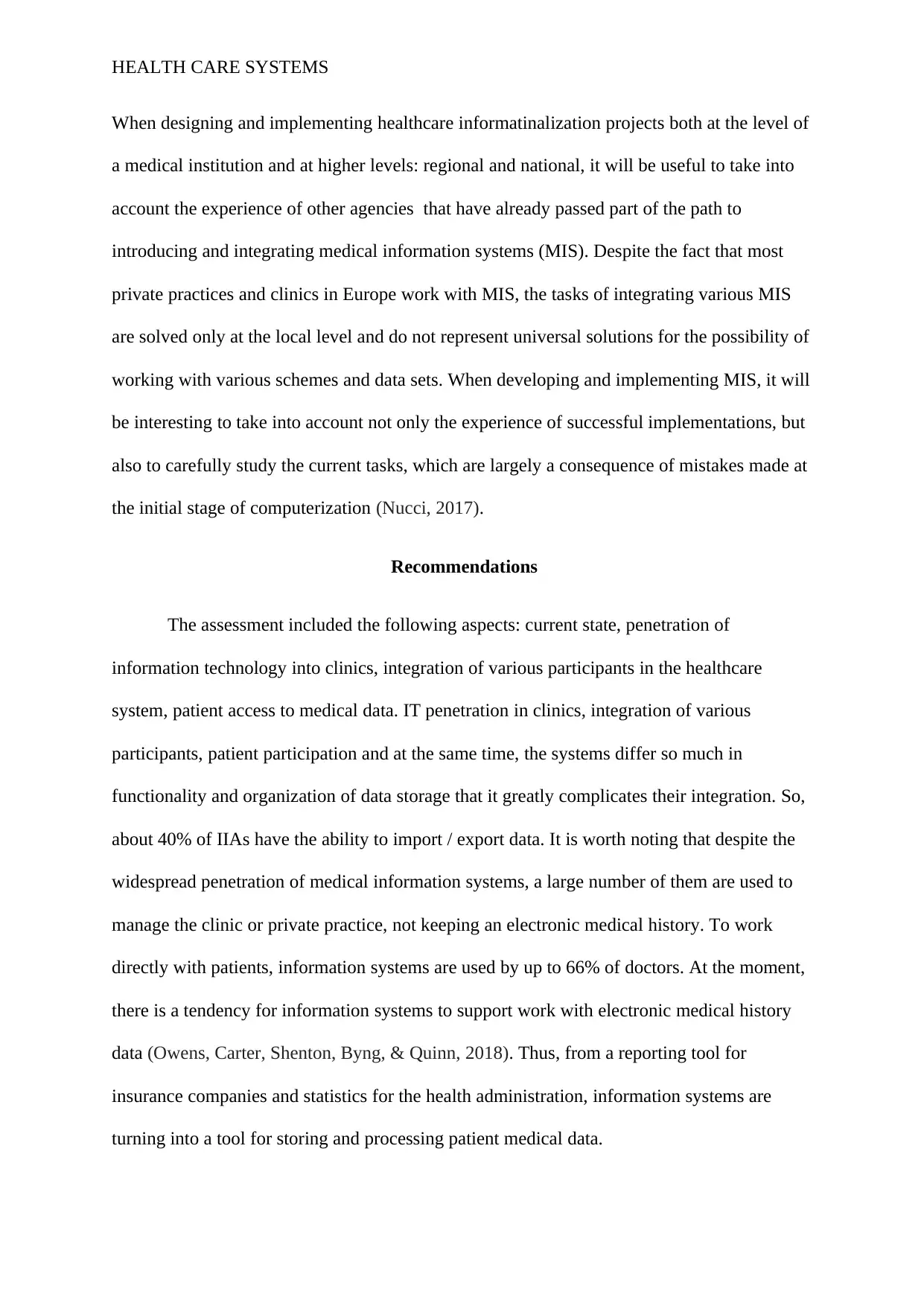
HEALTH CARE SYSTEMS
When designing and implementing healthcare informatinalization projects both at the level of
a medical institution and at higher levels: regional and national, it will be useful to take into
account the experience of other agencies that have already passed part of the path to
introducing and integrating medical information systems (MIS). Despite the fact that most
private practices and clinics in Europe work with MIS, the tasks of integrating various MIS
are solved only at the local level and do not represent universal solutions for the possibility of
working with various schemes and data sets. When developing and implementing MIS, it will
be interesting to take into account not only the experience of successful implementations, but
also to carefully study the current tasks, which are largely a consequence of mistakes made at
the initial stage of computerization (Nucci, 2017).
Recommendations
The assessment included the following aspects: current state, penetration of
information technology into clinics, integration of various participants in the healthcare
system, patient access to medical data. IT penetration in clinics, integration of various
participants, patient participation and at the same time, the systems differ so much in
functionality and organization of data storage that it greatly complicates their integration. So,
about 40% of IIAs have the ability to import / export data. It is worth noting that despite the
widespread penetration of medical information systems, a large number of them are used to
manage the clinic or private practice, not keeping an electronic medical history. To work
directly with patients, information systems are used by up to 66% of doctors. At the moment,
there is a tendency for information systems to support work with electronic medical history
data (Owens, Carter, Shenton, Byng, & Quinn, 2018). Thus, from a reporting tool for
insurance companies and statistics for the health administration, information systems are
turning into a tool for storing and processing patient medical data.
When designing and implementing healthcare informatinalization projects both at the level of
a medical institution and at higher levels: regional and national, it will be useful to take into
account the experience of other agencies that have already passed part of the path to
introducing and integrating medical information systems (MIS). Despite the fact that most
private practices and clinics in Europe work with MIS, the tasks of integrating various MIS
are solved only at the local level and do not represent universal solutions for the possibility of
working with various schemes and data sets. When developing and implementing MIS, it will
be interesting to take into account not only the experience of successful implementations, but
also to carefully study the current tasks, which are largely a consequence of mistakes made at
the initial stage of computerization (Nucci, 2017).
Recommendations
The assessment included the following aspects: current state, penetration of
information technology into clinics, integration of various participants in the healthcare
system, patient access to medical data. IT penetration in clinics, integration of various
participants, patient participation and at the same time, the systems differ so much in
functionality and organization of data storage that it greatly complicates their integration. So,
about 40% of IIAs have the ability to import / export data. It is worth noting that despite the
widespread penetration of medical information systems, a large number of them are used to
manage the clinic or private practice, not keeping an electronic medical history. To work
directly with patients, information systems are used by up to 66% of doctors. At the moment,
there is a tendency for information systems to support work with electronic medical history
data (Owens, Carter, Shenton, Byng, & Quinn, 2018). Thus, from a reporting tool for
insurance companies and statistics for the health administration, information systems are
turning into a tool for storing and processing patient medical data.
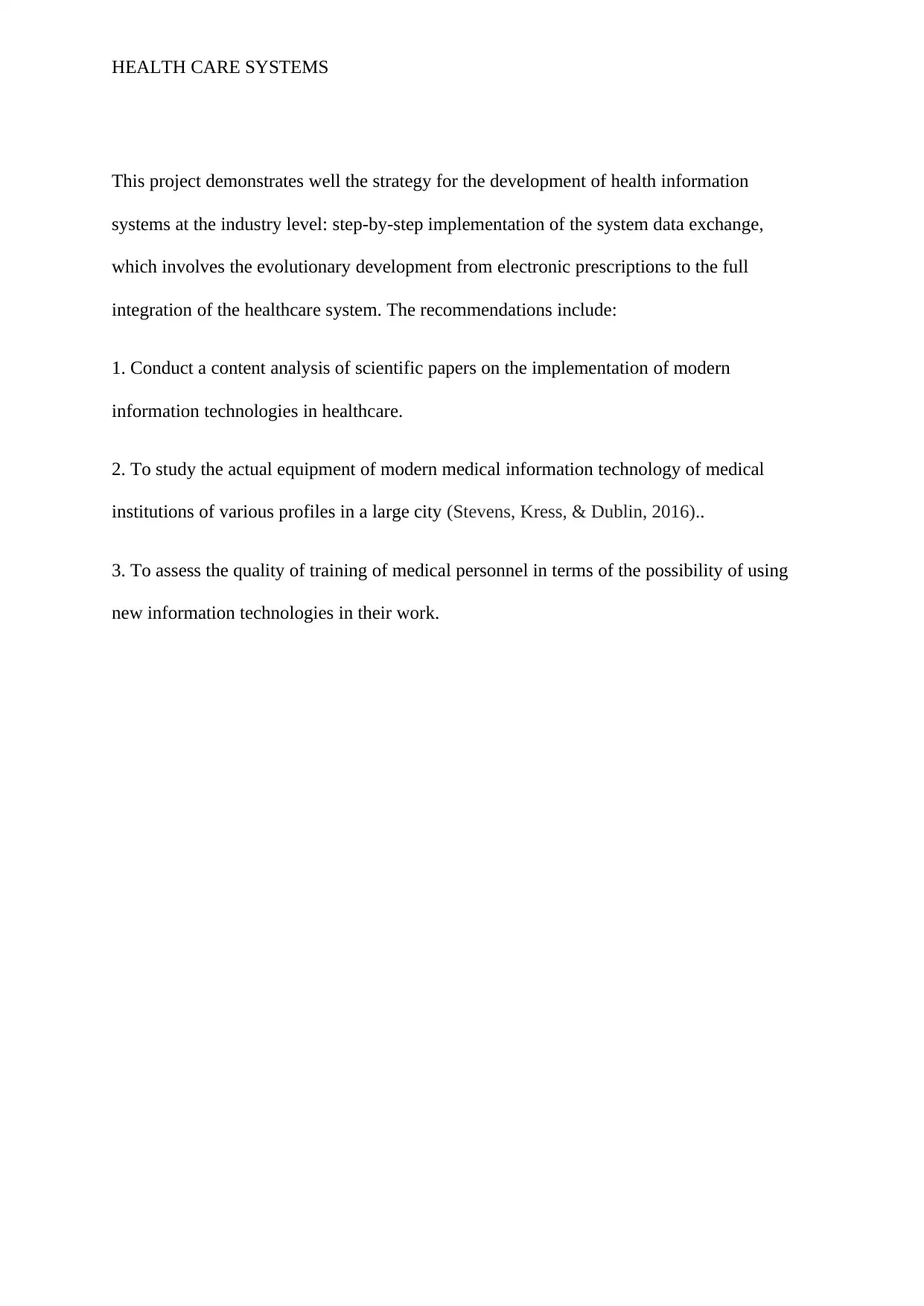
HEALTH CARE SYSTEMS
This project demonstrates well the strategy for the development of health information
systems at the industry level: step-by-step implementation of the system data exchange,
which involves the evolutionary development from electronic prescriptions to the full
integration of the healthcare system. The recommendations include:
1. Conduct a content analysis of scientific papers on the implementation of modern
information technologies in healthcare.
2. To study the actual equipment of modern medical information technology of medical
institutions of various profiles in a large city (Stevens, Kress, & Dublin, 2016)..
3. To assess the quality of training of medical personnel in terms of the possibility of using
new information technologies in their work.
This project demonstrates well the strategy for the development of health information
systems at the industry level: step-by-step implementation of the system data exchange,
which involves the evolutionary development from electronic prescriptions to the full
integration of the healthcare system. The recommendations include:
1. Conduct a content analysis of scientific papers on the implementation of modern
information technologies in healthcare.
2. To study the actual equipment of modern medical information technology of medical
institutions of various profiles in a large city (Stevens, Kress, & Dublin, 2016)..
3. To assess the quality of training of medical personnel in terms of the possibility of using
new information technologies in their work.
⊘ This is a preview!⊘
Do you want full access?
Subscribe today to unlock all pages.

Trusted by 1+ million students worldwide
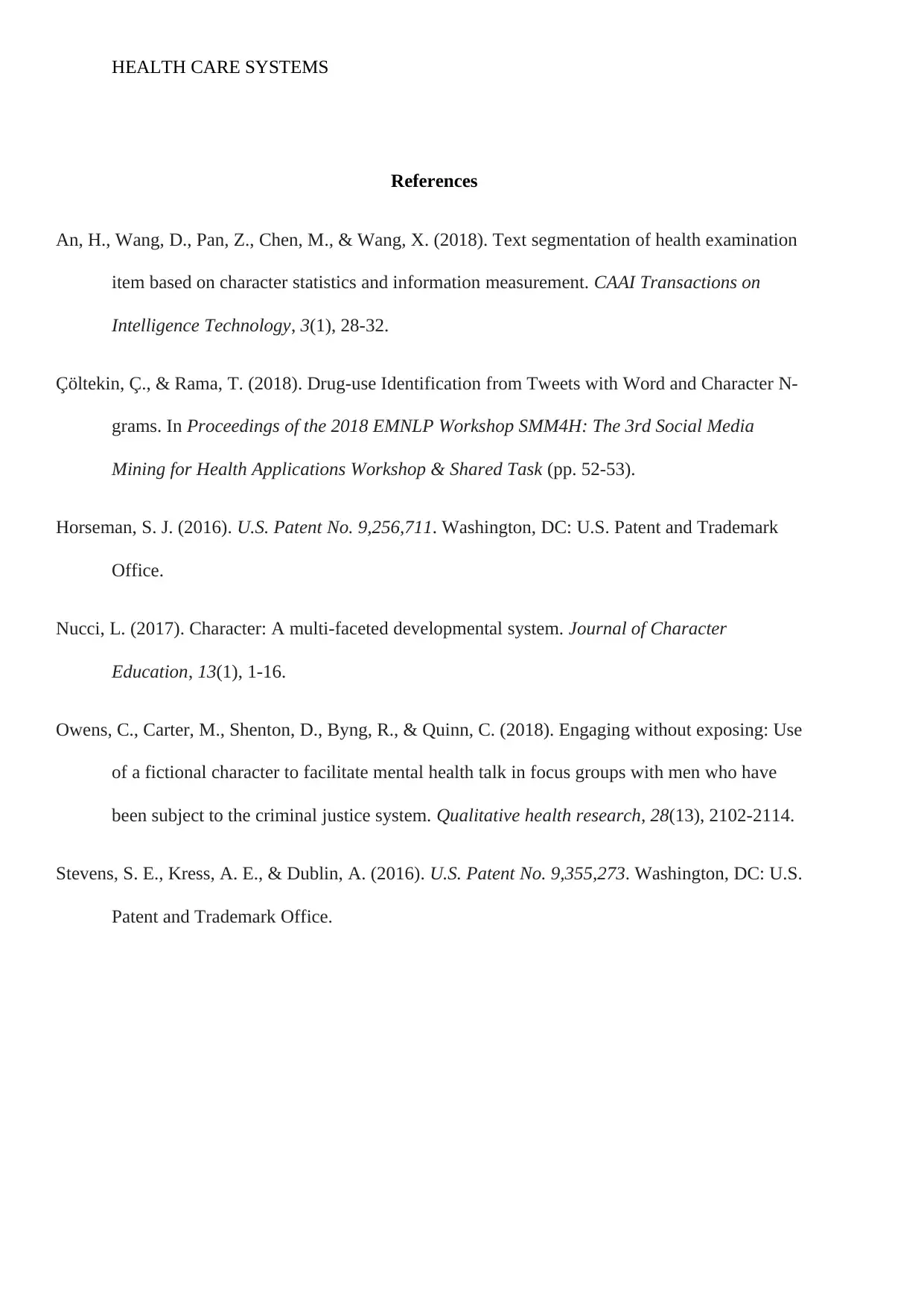
HEALTH CARE SYSTEMS
References
An, H., Wang, D., Pan, Z., Chen, M., & Wang, X. (2018). Text segmentation of health examination
item based on character statistics and information measurement. CAAI Transactions on
Intelligence Technology, 3(1), 28-32.
Çöltekin, Ç., & Rama, T. (2018). Drug-use Identification from Tweets with Word and Character N-
grams. In Proceedings of the 2018 EMNLP Workshop SMM4H: The 3rd Social Media
Mining for Health Applications Workshop & Shared Task (pp. 52-53).
Horseman, S. J. (2016). U.S. Patent No. 9,256,711. Washington, DC: U.S. Patent and Trademark
Office.
Nucci, L. (2017). Character: A multi-faceted developmental system. Journal of Character
Education, 13(1), 1-16.
Owens, C., Carter, M., Shenton, D., Byng, R., & Quinn, C. (2018). Engaging without exposing: Use
of a fictional character to facilitate mental health talk in focus groups with men who have
been subject to the criminal justice system. Qualitative health research, 28(13), 2102-2114.
Stevens, S. E., Kress, A. E., & Dublin, A. (2016). U.S. Patent No. 9,355,273. Washington, DC: U.S.
Patent and Trademark Office.
References
An, H., Wang, D., Pan, Z., Chen, M., & Wang, X. (2018). Text segmentation of health examination
item based on character statistics and information measurement. CAAI Transactions on
Intelligence Technology, 3(1), 28-32.
Çöltekin, Ç., & Rama, T. (2018). Drug-use Identification from Tweets with Word and Character N-
grams. In Proceedings of the 2018 EMNLP Workshop SMM4H: The 3rd Social Media
Mining for Health Applications Workshop & Shared Task (pp. 52-53).
Horseman, S. J. (2016). U.S. Patent No. 9,256,711. Washington, DC: U.S. Patent and Trademark
Office.
Nucci, L. (2017). Character: A multi-faceted developmental system. Journal of Character
Education, 13(1), 1-16.
Owens, C., Carter, M., Shenton, D., Byng, R., & Quinn, C. (2018). Engaging without exposing: Use
of a fictional character to facilitate mental health talk in focus groups with men who have
been subject to the criminal justice system. Qualitative health research, 28(13), 2102-2114.
Stevens, S. E., Kress, A. E., & Dublin, A. (2016). U.S. Patent No. 9,355,273. Washington, DC: U.S.
Patent and Trademark Office.
1 out of 7
Related Documents
Your All-in-One AI-Powered Toolkit for Academic Success.
+13062052269
info@desklib.com
Available 24*7 on WhatsApp / Email
![[object Object]](/_next/static/media/star-bottom.7253800d.svg)
Unlock your academic potential
Copyright © 2020–2025 A2Z Services. All Rights Reserved. Developed and managed by ZUCOL.





